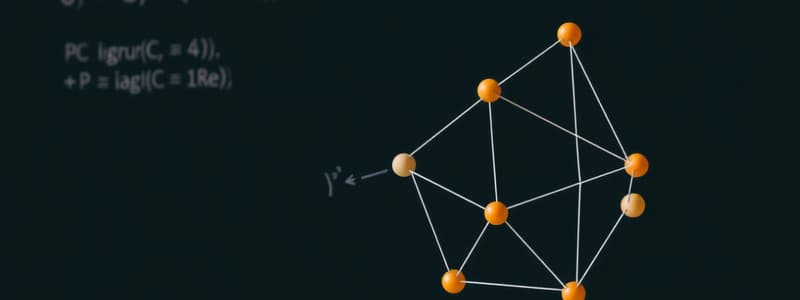Podcast
Questions and Answers
Which class consists of problems whose computing time is bounded by polynomials of small degree?
Which class consists of problems whose computing time is bounded by polynomials of small degree?
- NP Class
- P Class (correct)
- Intractable Class
- NP Hard Class
What is true about NP Class problems?
What is true about NP Class problems?
- They require super polynomial or exponential time to solve. (correct)
- They always have polynomial time algorithms.
- They are all easy problems.
- They can be solved in polynomial time.
Which algorithm operates with a time complexity of O(n log n)?
Which algorithm operates with a time complexity of O(n log n)?
- Merge Sort (correct)
- Knapsack Problem
- Binary Search
- Insertion Sort
What characterizes a deterministic algorithm?
What characterizes a deterministic algorithm?
Which operation is associated with non-deterministic algorithms according to the content?
Which operation is associated with non-deterministic algorithms according to the content?
What does NP Hard refer to?
What does NP Hard refer to?
Which of the following problems is typically classified as an NP Complete problem?
Which of the following problems is typically classified as an NP Complete problem?
What is an example of a decision problem mentioned in the content?
What is an example of a decision problem mentioned in the content?
What is the time complexity for the functions Choice(), Success(), and Failure() in a nondeterministic algorithm?
What is the time complexity for the functions Choice(), Success(), and Failure() in a nondeterministic algorithm?
What condition leads to the unsuccessful termination of a nondeterministic algorithm?
What condition leads to the unsuccessful termination of a nondeterministic algorithm?
In a nondeterministic search algorithm, what does writing index 'j' signify?
In a nondeterministic search algorithm, what does writing index 'j' signify?
What kind of machine is capable of handling nondeterministic algorithms?
What kind of machine is capable of handling nondeterministic algorithms?
In the given nondeterministic sorting algorithm, what does line 8 check for?
In the given nondeterministic sorting algorithm, what does line 8 check for?
Why is the sorting algorithm considered to have a complexity of O(N)?
Why is the sorting algorithm considered to have a complexity of O(N)?
How does nondeterministic searching differ from deterministic searching in terms of efficiency?
How does nondeterministic searching differ from deterministic searching in terms of efficiency?
What output is produced by a process upon successful completion?
What output is produced by a process upon successful completion?
What is indicated by a failure signal in a nondeterministic algorithm?
What is indicated by a failure signal in a nondeterministic algorithm?
What does an optimization problem aim to identify?
What does an optimization problem aim to identify?
In the context of reducibility, what does it mean if problem L1 reduces to problem L2?
In the context of reducibility, what does it mean if problem L1 reduces to problem L2?
What is a maximal clique in a graph?
What is a maximal clique in a graph?
What is the decision problem associated with the Max Clique problem?
What is the decision problem associated with the Max Clique problem?
What is the implication of an optimization problem being classified as NP Hard?
What is the implication of an optimization problem being classified as NP Hard?
What happens if the decision problem cannot be solved in polynomial time?
What happens if the decision problem cannot be solved in polynomial time?
What distinguishes a nondeterministic algorithm (NDA) from a deterministic algorithm?
What distinguishes a nondeterministic algorithm (NDA) from a deterministic algorithm?
What is a key feature of a deterministic interpretation of a non-deterministic algorithm?
What is a key feature of a deterministic interpretation of a non-deterministic algorithm?
What characterizes a non-deterministic machine (NDM)?
What characterizes a non-deterministic machine (NDM)?
What does NPC theory indicate about polynomial time algorithms for NP class problems?
What does NPC theory indicate about polynomial time algorithms for NP class problems?
Which statement accurately defines NP Complete problems?
Which statement accurately defines NP Complete problems?
What is true regarding NP Hard problems?
What is true regarding NP Hard problems?
How is a decision problem defined?
How is a decision problem defined?
Which of the following is true about the relationship between NP Complete and NP Hard problems?
Which of the following is true about the relationship between NP Complete and NP Hard problems?
Why is the non-deterministic computation model considered powerful?
Why is the non-deterministic computation model considered powerful?
Flashcards are hidden until you start studying
Study Notes
Output of Algorithms
- Returns 1 for successful completion and 0 for unsuccessful termination.
Optimization Problems
- Involve finding an optimal value (maximum or minimum) for a cost function.
- May be NP Hard.
Satisfiability Problem
- Determines if a given expression holds true for some truth value assignments to its variables.
Key Definitions
- Clique: A complete subgraph within a graph, defined by the number of vertices it contains.
- Reducibility: If a problem L2 can be solved in polynomial time, and L1 can be solved using the same algorithm, L1 reduces to L2 (L1 α L2).
- α: A transitive relation.
Non-Deterministic Algorithms (NDA)
- NDAs can lead to multiple completions based on various choices; e.g., equal numbers in an array can result in many sorted permutations.
- Successful completion: output 1; Unsuccessful: output 0.
- Implicit output statements indicate success or failure through signals.
Decision Problems and their Importance
- Many optimization problems can be reformulated as decision problems.
- A decision problem solvable in polynomial time implies its corresponding optimization problem is also solvable in polynomial time.
- If the decision problem isn't solvable in polynomial time, the optimization problem isn't either.
Maximal Clique Problem
- A maximal complete subgraph in a graph G(V,E) is known as a clique.
- The size of the maximal clique is measured by the number of vertices.
- The Max Clique problem seeks to find the largest clique in graph G.
- The corresponding decision problem checks if G has a clique of size at least k.
Computational Complexity Classes
- Fundamental concepts include P, NP, NP Hard, and NP Complete classes.
- Problems categorized based on the best-known algorithm's computing time.
P Class
- Involves problems where computing time is bounded by polynomials of small degree (tractable).
- Examples:
- Insertion Sort: O(n²)
- Merge and Quick Sort: O(n log n)
- Binary Search: O(log n)
NP Class
- Contains problems with non-polynomial computing time.
- Examples: TSP (O(n² 2n)), Knapsack Problem (O(2^n/2)).
- No known polynomial time algorithms exist for NP class problems, making them intractable.
Deterministic vs Non-Deterministic Algorithms
- Deterministic Algorithm: Every operation's outcome is defined, consistent with computer program execution.
- Non-Deterministic Algorithm: Outcomes are limited to specific possibilities, allowing for arbitrary choices under defined termination conditions.
Non-Deterministic Functions
- Choice(S): Arbitrarily selects an element from set S.
- Success() / Failure(): Signals the outcome of the algorithm.
- Execution time for choice and outcome functions is O(1).
Non-Deterministic Search and Sorting
- Search Example: Non-deterministically identifies an element in a set leading to O(1) complexity.
- Sorting Example (Nsort): Sorts positive numbers by allowing choices for positioning while ensuring order verification.
Understanding Non-Deterministic Algorithms
- They can be interpreted deterministically via unbounded parallelism, where multiple algorithm copies explore choices simultaneously.
- The first successful completion stops other copies.
Non-Deterministic Machine (NDM)
- Fictitious machine capable of choosing the correct element from choices, ensuring a successful outcome in one unit of time.
NPC Theory
- Does not provide methods for polynomial time algorithms for NP Class problems.
- Identifies computational relationships among problems with no known polynomial time solutions.
Categories of Problems
- NP Complete (NPC): If one NPC problem can be solved in polynomial time, all can be.
- NP Hard: If an NP Hard problem is polynomially solvable, all NPC problems can be solved in polynomial time.
- All NPC problems are NP Hard, but some NP Hard problems are not NPC.
Conclusion
- Focus should shift to understanding nondeterministic computations since neither NPC nor NP Hard problems are polynomially solvable.
Studying That Suits You
Use AI to generate personalized quizzes and flashcards to suit your learning preferences.




